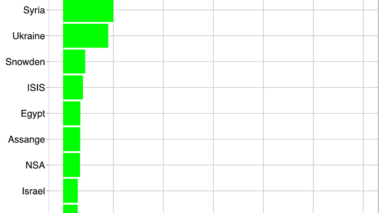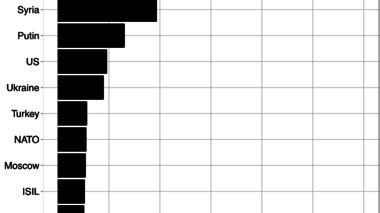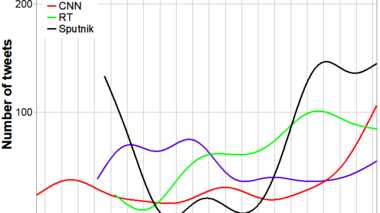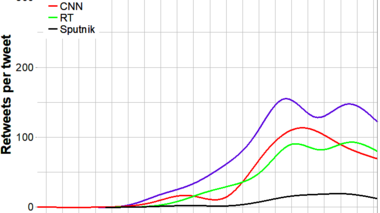Russian state-sponsored media and disinformation on Twitter

Disinformation has been defined as the purposeful dissemination of false or misleading information aimed at deceiving or confusing the reader and promoting one’s own agenda. Russian state-sponsored media have long been accused of the deliberate and systematic generation and dissemination of disinformation. In particular, critics have highlighted the negative roles of the Russian state-owned TV network RT (formerly Russia Today) and of the news agency Sputnik in the context of US and European elections, the investigation into the 2014 downing of Malaysia Airlines flight MH17, and political events in Ukraine, such as the 2004–2005 Orange Revolution and the 2014 Euromaidan antigovernment protests.
In fact, Ukraine is one of the most frequent targets of Kremlin-sponsored disinformation, and much of this disinformation takes place on social media. As a result, policymakers and social media platforms are trying to regulate what can be shared on social media and create solutions that can detect such content and help tackle the spread of false information.
Russian state-sponsored media do not necessarily produce the original disinformation. Instead, they often retransmit false information produced by state actors, report half-truths, and provide a platform for conspiracy theories. For example, by resharing multiple mutually contradicting interpretations of the downing of flight MH17, RT and Sputnik spread fabrications produced by Russian state and state-affiliated actors. One such actor was the arms manufacturer Almaz-Antey, which repeatedly questioned the conclusions of the joint investigation team (JIT) by arguing that the company had ‘alternative evidence’ that the JIT had purposefully ignored.
Topics covered by the Russian media
To identify the main topics covered by the Russian state-owned news media, we collected and analysed almost half a million Twitter posts by RT and Sputnik. The data were gathered from the two outlets’ official English-language accounts and cover the period from 2009 to 2017.
Social media form an important element in disinformation campaigns. Social media allow for the fast and effective spread of information, enabling audiences to engage with it by commenting on and resharing news. For example, the use of hashtags can make tweets easier to search and allow others to find messages with a specific theme or content.
Our analysis provides the first systematic, longitudinal assessment of the topics covered by RT and Sputnik and the extent to which their tweets resonate among social media users. One of the first striking results is that Ukraine received significant attention in RT and Sputnik posts in the period studied (figures 1 and 2). Tweets containing the hashtag #Ukraine were the third most frequent on RT; only posts including #news and #Syria were more numerous on RT. About 10 per cent of all RT tweets were about Ukraine. Likewise, Sputnik posted frequently about Ukraine, with such tweets accounting for a similar share of the total to those of RT. Sputnik, however, tweeted slightly more often about the US, Russian president Vladimir Putin, Syria, and Russia.


Russian vs. Western social media activity
The overall level of activity of Russian media in the period analysed was comparable with that of reputable Western media. Yet, Russian media content on Twitter receives less engagement. For example, the BBC and CNN each tweeted on average about 70 times a day in mid-2017, while Sputnik posted about 150 tweets a day and RT about 80 (figure 3). However, when it came to engagement among social media users, Sputnik substantially underperformed, with about ten retweets per tweet in 2017, compared with the BBC’s and CNN’s 80–150 retweets (figure 4). RT, however, received a similar number of retweets to the BBC and CNN.


These data show that RT and Sputnik, which are often labelled the Kremlin’s mouthpieces, addressed the same sets of issues but received different levels of attention from their respective audiences. A possible explanation for this observation could be that the readerships of these media are limited by their—at times, extreme—anti-Western and conspiracy-based narratives. This explanation may be especially relevant for Sputnik, which appeals to marginal and, sometimes, radical perspectives more often than RT does. It can be argued that such marginal narratives do not appeal to the broader public, who find that RT’s tweets resonate with them much more than Sputnik’s.
Questions that need answers
In sum, RT and Sputnik cover similar sets of topics and produce similar numbers of tweets. At the same time, Sputnik’s Twitter posts are retweeted less often than RT’s. This implies that policies to deal with media that systematically spread dissemination should primarily address the activities of RT, as the TV network clearly has much greater capacity to produce messages that are widely shared.
To establish why audiences engage with these two media outlets, further research is required. In particular, it needs to be established what messages are spread on social media platforms and under what conditions, and whether disinformation is shared more widely than objective reporting. Likewise, future research should consider investigating the effects of disinformation spread by RT and Sputnik on social media platforms.
Karina Shyrokykh is a researcher at Stockholm University and the Swedish Institute of International Affairs.